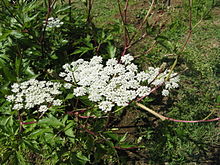| Angelica acutiloba | |
|---|---|

| |
| A. acutiloba | |
| Scientific classification | |
| Kingdom: | Plantae |
| Clade: | Tracheophytes |
| Clade: | Angiosperms |
| Clade: | Eudicots |
| Clade: | Asterids |
| Order: | Apiales |
| Family: | Apiaceae |
| Genus: | Angelica |
| Species: | A. acutiloba
|
| Binomial name | |
| Angelica acutiloba | |
| Varieties | |
| |
Angelica acutiloba is a perennial herb from the family Apiaceae or Umbelliferous (carrot or parsley family). It is predominately in Japan and perhaps endemic (unique).[1] It is now distributed widely and cultivated in Jilin, China,[2] Korea,[2] Taiwan[3] and Indonesia.[2]
The common name of Angelica acutiloba is known as tōki (トウキ, 当帰) in Japanese. The root was used as a substitute for the crude drug tōki (当帰) in Kampō medicine (漢方製薬 Kanpō Seiyaku), which is a Japanese adaptation of Traditional Chinese medicine.
The Traditional Chinese medicine uses the root of a different species A. sinensis, Chinese: 当归; pinyin: dāngguī. The Latin pharmacological name for the crude drug, Radix Angelica sinensis, refers to the dried roots of A. sinensis. In China, as a substitute species, A. acutiloba, is known as Chinese: 东当归; pinyin: dōngdāngguī. Literally “东” means “eastern” or “东洋”, which is equivalent to the meaning of Japan. So the medicine is also called as Japanese Angelica root. (See #Etymology) The Japanese name, tōki (トウキ, 当帰), has a literally meaning like “recovering good health”.[4]
- ^ Downie, Stephen R.; Watson, Mark F.; Spalik, Krzysztof; Katz-Downie, Deborah S. (2000). "Molecular systematics of Old World Apioideae(Apiaceae): relationships among some members of tribe Peucedaneae sensu lato, the placement of several island-endemic species, and resolution within the apioid superclade". Can. J. Bot. 78 (4): 506–528. doi:10.1139/cjb-78-4-506.
- ^ a b c Cite error: The named reference
USDA Angelica acutilobawas invoked but never defined (see the help page). - ^ Namba, Tsuneo (難波恒雄) (1970). 漢方薬入門 (Kampoyaku nyumon). Hoikusha., p.25
- ^ Cite error: The named reference
Angelica acutilobawas invoked but never defined (see the help page).